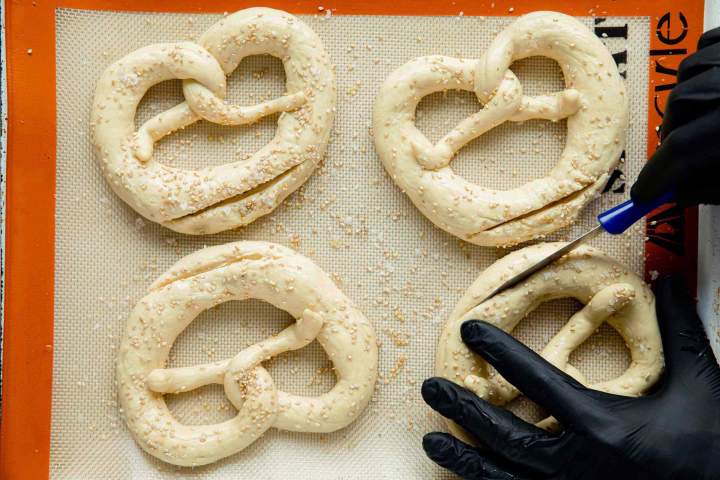METHOD
-
Baked baking soda
Preheat your oven to 250°C / 480 °F. Add baking soda to an oven-safe skillet or small baking dish. Evenly spread the baking soda over the dish. Place in the preheated oven and bake for 1 hour at 250°C / 480 °F. Remove from the oven, leave the soda to cool, then transfer to an airtight container.
-
pretzel dough
Stir to combine all-purpose flour, bread flour, yeast, sugar, and water in a large bowl. Generously flour the working surface and knead the dough with your hands for about 5 minutes, or use a stand mixer fitted with a dough hook and knead for about 2 - 3 minutes. Add salt and softened cubes of butter. Continue to knead by hand for about 5 minutes, or use a stand mixer and knead for 3 - 4 minutes. Cover with cling film or kitchen towel and leave to proof at room temperature for about 50 - 60 minutes or doubled in size.
TipIf you are using fresh yeast, the process is slightly different. Combine lukewarm water, sugar, and fresh yeast in a bowl. Set aside for 5 minutes for the yeast to start rising. Then add the yeast mixture to the flour and continue with the recipe. Water temperature should be 35°C / 95°F, not more. -
Shape the dough
Line two large baking sheets with silpat or parchment paper. Lightly grease with vegetable oil. Divide the dough into 8 parts (each weighing approx. 100g / 3.5 oz). Using your hand, press down each piece of the dough to degas, then roll into a cylinder (or mini baguette) approx. 12 cm / 5-inches long. Place each cylinder onto your prepared baking sheet. Roll each cylinder of dough into a 35 cm / 14-inches long rope. Create a thicker section in the center of the rope by rolling the rope on each side of that thicker section. Roll into a 60 - 70 cm / 24-inches - 25-inches long rope.
-
Shape into the pretzels
Shape each piece of dough into a traditional Bavarian pretzel. Grab the two ends of the rope and shape it into a letter U - check the photo. Cross both ends of the rope - check the photo, then fold the same side over the other to create two twists. Now grab both ends (tips) and fold them over the twist (knot) to create a pretzel shape - check the photo. Gently press down to seal. Repeat the process with the remaining pretzels. Cover with cling film or kitchen towel and leave to proof at room temperature for 25 - 30 minutes. Then uncover the pretzels and place them in the fridge for another hour or in a freezer for about 20 - 25 minutes for the pretzels to help pretzels keep their beautiful shape while dipping in the soda bath. Preheat your oven to 240°C / 465 °F.
-
soda bath
Make the soda bath. Put on the rubber or latex gloves. Pour 500 ml (2 cups + 2 tbsp) of cold water into a glass or stainless steel bowl. While lightly whisking with a stainless steel whisk or spoon, gradually stir in 75g or 1/3 cup baked baking soda. Stir until the baked baking soda is dissolved. Remove the pretzels from your fridge or freezer. Dip each pretzel into the soda bath for one minute with the upper side down. Transfer to a baking sheet lined with parchment paper or silpat with presentation side up. Optionally sprinkle with sesame seeds or pretzel salt. Score each pretzel with a sharp knife (as seen in the photo).
TipUse rubber or latex gloves to prevent an allergic reaction. The baked baking soda is caustic (corrosive) with the ph of around 12.If you use lye (sodium hydroxide), it's essential to use rubber or latex gloves and protective goggles (optional). Make a 4% lye solution by pouring cold water into a glass or stainless steel bowl. Gradually stir in 20g (0.7 oz) of the food-grade lye (sodium hydroxide). Dip each shaped and proofed pretzel into the lye solution for about 30 seconds instead of 1 minute. -
bake and serve
Bake each baking sheet with pretzels separately. Place the first baking sheet of pretzels into the preheated oven. Bake for 10 minutes at 230 °C / 445 °F, then open the oven to release the steam. Reduce the heat to 210 °C / 410 °F and continue to bake for another 10 - 12 minutes. Remove from the oven and let it cool slightly on a wire rack. It's best to eat these bavarian pretzels still a bit warm. Store in an airtight container at room temperature for up to 2 days or freeze for up to 2 months.
























